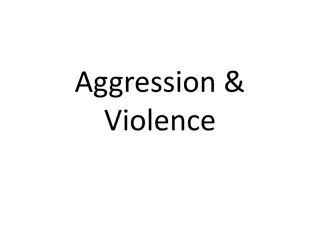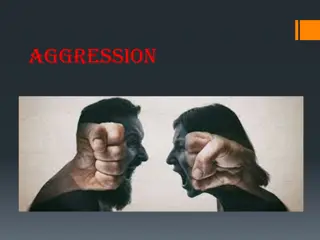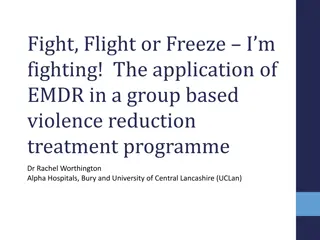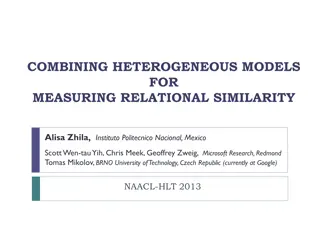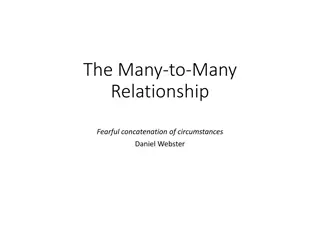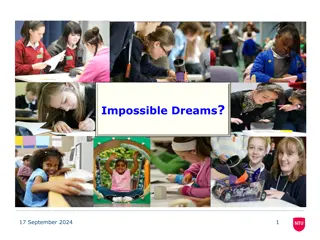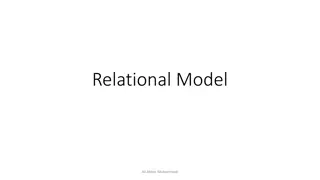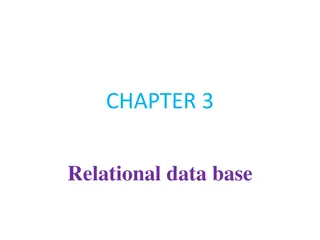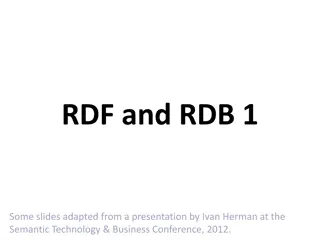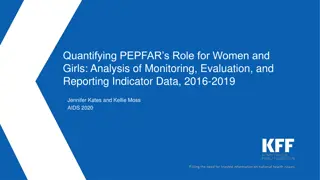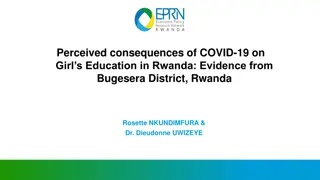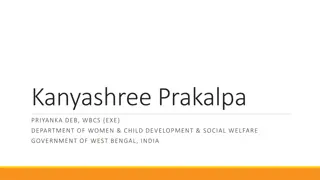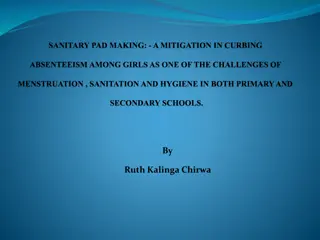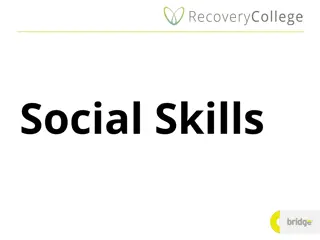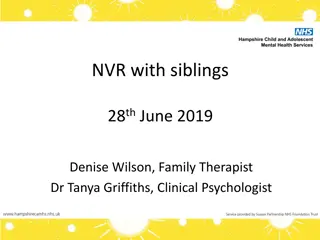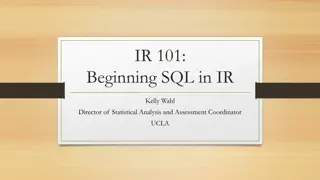Understanding Relational Aggression in Girls: The Impact on Social Relationships
Relational aggression, a form of social bullying, can have detrimental effects on girls' social relationships and self-esteem. This type of indirect aggression includes behaviors like exclusion, spreading rumors, and social manipulation. Understanding and assessing relational aggression is crucial for addressing conflicts and promoting healthier dynamics among girls.
Download Presentation

Please find below an Image/Link to download the presentation.
The content on the website is provided AS IS for your information and personal use only. It may not be sold, licensed, or shared on other websites without obtaining consent from the author. Download presentation by click this link. If you encounter any issues during the download, it is possible that the publisher has removed the file from their server.
E N D
Presentation Transcript
Relational Aggression: Sugar and Spice But Not Always Nice! Ann D. Collier, Ph.D. Psychology Department Northern Arizona University
Mean Girls Bullying typically refers to direct aggression, or an overt physical act or assault Relational Aggression (social aggression) is indirect and is aimed at damaging another s self-esteem, social status, or both. It can include: verbal threats, social exclusion ostracism malicious gossip scapegoating secret telling threats of friendship withdrawal Non-verbal communication
How to assess relational aggression Look at the frequency and intensity of behaviors; ask child, mother, teacher. Believe the child! Exclusion to upset the child Pressure to do things s/he doesn t want to do Lies or nasty things said about others Games spoiled Tricked in a nasty way Called nasty names
Which of these are Normal? Every Saturday night a girl in your class has a party. She invites all your friends but never invites you. One Friday you wear a new dress to school and your best friend tells you on the way to class that it makes you look fat. A girl in your class regularly starts rumors about people at school that are not true. A group of girls is passing notes in class and when certain people raise their hands, all of the girls giggle. Raskauskas& Stoltz (2004)
Girls are Supposed to be Friends! Childhood typically spent practicing caretaking and nurturing, e.g., with dolls Best friends discover joys of intimacy and connection Belonging to a peer group bolsters confidence and reinforces identity; protects the child from isolation and victimization
When there is conflict amongst friends . Girls are deeply intertwined and threatened when faced with conflict or disagreement Girls are socialized away from aggression; unprepared to negotiate conflict. Minor disagreement can call an entire relationship into question Anger can t be voiced; they are not taught skills to handle conflict. In fact, they are more often taught to manage their anger and disappointment covertly Passivity is reinforced by same-sex peer group Adults minimize it as just being girls
Romantic relationships in girls Girls often turn to romantic relationships to meet their unmet social- emotional needs (again, without the skills) Associated with more stress or relationship violence in later heterosexual romantic relationships Need to learn to work it out with same-sex peers first! Pressure for romantic heterosexual relationships at a very young age Puts girls at risk for victimization because they lack the social skills to negotiate the increased dependency or intimacy with older males
In summary. So Why Are They so Mean? Girls put more emphasis on establishing close and intimate connections Girls are taught that aggression is unacceptable With few outlets to be assertive (or aggressive), girls are socialized to hurt each other through damaging peer relationships When girls are taught empathy and how to handle conflict appropriately, it lowers the chances of relational aggression
The role of healthy parenting Pro-social relationship develop with Warmth Attentiveness Consistent and clear limits Compliance rewarded Careful monitoring of activities. Teach child he/she is valued and provide safety; promote the development of skills as grow up
When families are maladaptive Failure to model pro-social skills and nurturance; failure to reward non-aggressive interactions Consistent use of harsh and coercive punishment Lack of supervision Greater risk of victimization of girls (e.g., 1 in 4 sexually abused)
When does it happen? Peaks in the middle school years Starts much younger, as early as 3rdgrade Shy or socially withdrawn children with depressive affect identified as future victims When it occurs, intensifies negative, depressed affect which increases isolation and vulnerability Female are more likely to fight with those with whom they have close relationships (family members, friends)
Why is middle school so rough? Changes from protected elementary school with smaller student-to-teacher ratio Fewer decision making opportunities, greater ability groupings (that segregate students), limited time to connect with teachers Bombarded with images of ideal physical attractiveness, minimally recognized for achievements, and pressured for heterosexual relationships before psychologically ready PRESSURE TO CONFORM
Who is at risk? Victims of Relational Aggression Characteristically more submissive, shy, socially awkward, feel isolated. Fewer close friendships to begin with Higher depressive symptoms and social anxiety; signals students they are insecure and will not fight back Higher fear of negative evaluation Over time, with prolonged victimization, they experience PTSD (trauma from social manipulation), lower self- esteem, sense of less control in lives
Long-term Impact of Bullying Victimization results in self-harm (intentionally hurt own body with any physical means) in multiple studies! Longer the bullying, greater self-injury Earlier the age (7-10 years of age) it starts, greater the behavior seen, even when controlling for domestic violence and maladaptive parenting, pre-existing psychopathology, low IQ Increases the risk for depression, loneliness and social isolation Exacerbates the impact of adverse family environment Associated with school failure, dropout, violent romantic relationships, teen pregnancy, becoming an abusive parent
What is self-injury? deliberate, direct, and self-inflicted destruction of body tissue resulting in immediate tissue damage, for purposes not socially sanctioned and without suicidal intent That said, it is important to note that individuals with a history of self-injury are at higher risk for suicide thoughts, gestures, and attempts ****nine times more likely to report having made a suicide attempt at some point in their life.
The Mean Girl Offenders Higher social status and positioned more centrally to their peers Have more power and influence over others and a need to dominate Perceived as more confident and popular, even if they don t feel that internally Believe that antisocial behaviors are acceptable: it is okay to do this. Greater hyperactivity (in boys)
Provocative Victim: Bully/Victim Have characteristics of both More problems than non-victimized females with social anxiety and peer relationships; feel lonely Have been bullied Perpetrate socially aggressive behavior Hold accepting attitude toward antisocial behaviors (allows them to participate without remorse)
What can you do? Help create friendship groups Children with friends are less likely to be victimized The group retaliates to protect their friends and scare away aggressor Less frequently alone and less likely identified as a target Friends provide advice on how to deal with aggressor The more best friends the better However, friendships that are fraught with conflict and betrayal leave children more vulnerable
What can you do? Help Girls Make Peace With Aggression Girls need to learn to embrace acts of assertion Healthier relationships with aggression Understand the feelings that precede anger and conflict (e.g., frustration, intolerance) Don t reward manipulation Teach to confront, not to be conflict avoidance Give the group assertiveness skills as protection
Successful School Ingredients Set clear behavioral expectations with rewards for compliance and sanctions for aggressive interactions Increase teacher presence outside of classroom settings to monitor behaviors Increase presence of peer mentors/mediators, who are visible Teach conflict-mediating skills of active listening and compromise Include transition programs to provide information to incoming students into middle school Publicize your program
Suggested Programs for Intervening with Relational Aggression Friend to Friend Program (used more often with high risk girls) PRAISE (Preventing Relational Aggression in Schools Everyday) (for all kids) Social-cognitive training (learning to deal with anger) Application of social-cognitive training to rumors and peer entry situations Empathy building and perspective taking Recognizing role everyone plays as a community (e.g., bystander involvement)
Some good academic references Letendre, J. (2007). Sugar and Spice But Not Always Nice : Gender socialization and its impact on development and maintenance of aggression in adolescent girls. Child and Adolescent Social Work Journal, 24: 353-368. Malove, S.C. (2012). Using relational theory to treat adolescent girls victimized by social aggression. Clinical Social Work Journal. Published on line. Leff, S.S., Waasdorp, T.E., Paskewich, B., et al. (2010). The Preventing Relational Aggression in Schools Everyday Program: A preliminary evaluation of acceptability and impact. School Psychology Review, 39, 569-587.


